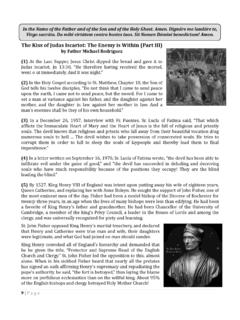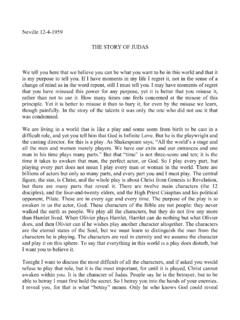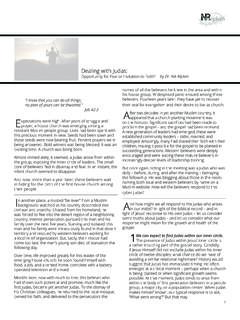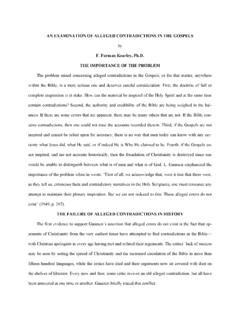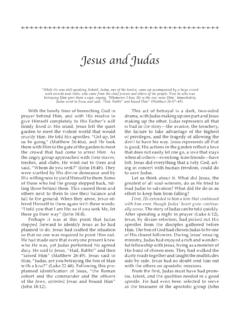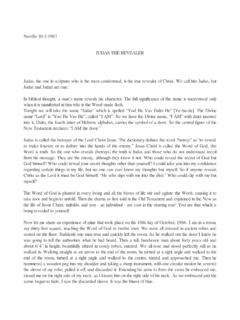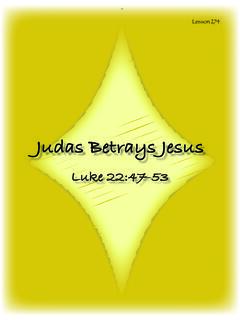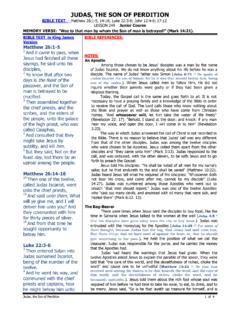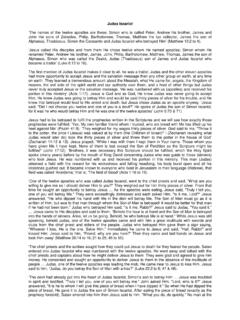Transcription of The Kiss of Judas: Themes of Betrayal and Forgiveness in ...
1 0 The kiss of judas : Themes of Betrayal and Forgiveness in the Scriptures Giotto Scrovegni Chapel, Padua, 1305-1306 Lenten Addresses 2013 Parish of Christ Church Windsor, Nova Scotia (Rev d) David Curry 1 The kiss of judas I judas , betrayest thou the Son of man with a kiss ? They are haunting and troubling words. All of the Gospels identify judas in one way or another as the betrayer of Christ, the grand paradigm in a way of all Betrayal . Luke alone has Jesus address judas with this telling question in the very moment of his being taken captive (Luke ), a chilling moment of truth and its Betrayal . Mark, with admirable economy of expression, has judas simply tell the crowd whomsoever I kiss , that same is he; take him, and lead him away safely. Whose safety, we may ask?
2 And as soon as he was come [ judas ] goeth straightway to him, and saith, Master, master; and kissed him (Mark 14. 44-45). Matthew identifies judas outright as the betrayer. Now the betrayer had given them a sign, saying, The one I shall kiss is the man; seize him. And he came up to Jesus at once and said, Hail, Master! And he kissed him (Matthew 26. 48-49). Only John says nothing about the kiss of judas , though he is very clear about judas Betrayal . Luke gives us this most intimate moment of Betrayal , a moment made ever so memorable by its intensity and its intimacy. It has, to be sure, captured the imagination of the artists, though depictions of the Betrayal , like the crucifixion itself, are relatively rare at least in early Christian art.
3 Apart from a few sarcophagi, the earliest artistic representation in a Church appears in Ravenna, Italy, at the Church of Sant Apollinare Nuova in a lovely mosaic dating to the sixth century. But perhaps the most arresting artistic representation of the Betrayal is Giotto s fresco in the Scrovegni Chapel in Padua (1305/6). In a way it has become iconic. There are other representations to be sure by Duccio in Sienna, Fra Angelico in Florence, and, later in the sixteenth century, Caravaggio in Rome, to name but a few - all of which connect the 2 Betrayal with violence as well. Are ye come out as against a thief, with swords and staves, to take me? Jesus says, (Mt. , Mk. ). There are representations in stone and wood and in stained glass, too, scattered among the Cathedrals and churches of Europe and beyond.
4 But one could hardly say that there was an excess of artistic representation of this momentous scene which is such a telling moment in the life of Christ. There is, after all, a disturbing quality about such a theme. One of my favourites is a wood carving from the sixteenth century in Germany (now in the Metropolitan Museum of Art in New York). It depicts judas embracing Christ and kissing him while Christ holds up his right hand in the gesture of peace and blessing to all of us as he looks, not at judas , but at us, the viewer. There is just that sense of disjunction between judas action and Christ s reaction. There is just that sense of divine compassion and Forgiveness in the face of our betrayals of his goodness and love. Of course, it is Giotto who captures all of that best and in the most astounding way.
5 In his portrayal, Jesus looks right at judas who is kissing him. We are convicted in the moment of our Betrayal . It is ever so powerful and moving. John in his theological way has judas convict himself and be convicted by Christ at the last supper in the same night that he was betrayed (BCP, p. 82), a theme that is captured in varying degrees of explicitness in the other gospel narratives, too, but nowhere more fully, perhaps, than in John s Gospel. With John, there is a kind of emphasis upon the Betrayal of intimacy and friendship something which we shall see in the larger witness of the Scriptures. At the last supper, Jesus says to the disciples, truly, truly, I say to you, one of you will betray me. This occasions some puzzlement and questioning to which Jesus replies, It is he to whom I shall give this morsel when I have dipped it.
6 So when he had 3 dipped the morsel, he gave it to judas , the son of Simon Iscariot. Then after the morsel, Satan entered into him. Jesus said to him, What you are going to do, do quickly (Jn ). What is this about? It is a feature of the knowing love of Christ. He does not go to the cross unknowingly or unwittingly, like Isaac in the sacrifice of Abraham who is the unknowing but intended victim. Nor is he like Socrates in his embrace of his sentence, for unlike Socrates, Jesus does not and cannot, we might say, drink the hemlock, take his own life directly, as it were. The crucifixion is sacrifice, not suicide. It is the strongest counter to the death culture of our age. We want power and control over all aspects of our lives and our deaths. We forget who we are.
7 It is one of the forms of Betrayal , a Betrayal of God and, paradoxically, of ourselves and of the logic of redemptive suffering. The Gospel accounts of the kiss of judas belong to the larger panorama of Betrayal and Forgiveness that has the beginnings of its shape and meaning in The Book of Genesis. The story of the Fall and the story of Cain and Abel provide two illustrations of the Themes of Betrayal and Forgiveness . The Fall A Betrayal of God in Christ, the story of the kiss of judas actually begins with the story of the Fall, the archetypal account of our Betrayal of God. Against the grand pageant of creation in chapters one and two, the third chapter of Genesis explains in mythic form the reality of our separation from God, from the created order, and from one another.
8 How is it a Betrayal ? Because the created order is something known and grasped in thought and part of that created order is God s commandment to the Adam, to our humanity. The whole assumption of the first two chapters of Genesis is that the world is intelligible, that it shows, as it were, something of the mind of the maker. Our humanity is at once grounded in the created order as the dust into which God has 4 breathed his spirit and as the creature who alone is said to be made in God s image. Humanity has a special role, too, in the created order; he has been given dominion over all of it. A loaded phrase, we misunderstand it if we assume that it means our dominance over the natural world as if it were simply dead stuff that exists for our manipulation and purpose.
9 Such is an essentially modern outlook and one which we have more than enough occasion to be skeptical about in our present day. Domination actually recalls us to the Lord, the Dominus, to the will of the Creator, in other words. Human domination can only belong to the divine will and purpose. The Adam our humanity in general - is also given to name every living creature , a wonderful and profound act of intellection which suggests the way in which human knowing participates in the divine understanding of what God has made. Our naming enters into the meaning of every living creature. Yet, again, this cannot mean that the world and all that is in it is or exists simply for us. It is God s world and our humanity is inescapably part of that world and part of it, too, intellectually and morally.
10 What the first two chapters of Genesis do not give us is much of a sense of our self-consciousness. Chapter three reveals the profound Judeo-Christian and Islamic sense of human self-consciousness that arises through division and separation, our division and separation from the truth of God. The story is at once the discovery and the Betrayal of human reason in the form of disobedience. Through the Fall we discover the implicit basis of our own existence, even the discovery of our reason through our Betrayal of what we have been given to know, namely, the essential goodness of the created order and therefore the essential rightness of the divine command not to eat of the tree of the knowledge of good and evil. 5 The story in its mythic form clearly shows the activity of human reason.
